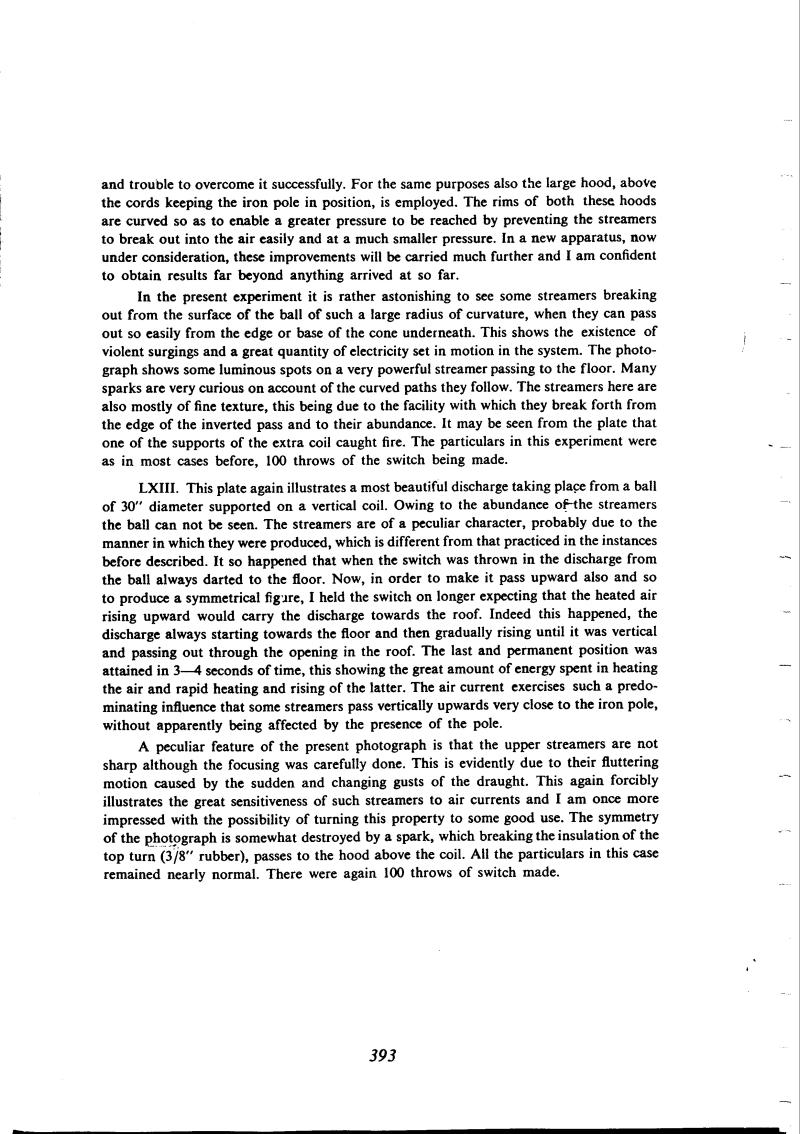and trouble to overcome it successfully. For the same purposes also the large hood, above the cords keeping the iron pole in position, is employed. The rims of both these hoods are curved so as to enable a greater pressure to be reached by preventing the streamers to break out into the air easily and at a much smaller pressure. In a new apparatus, now under consideration, these improvements will be carried much further and I am confident to obtain results far beyond anything arrived at so far.
In the present experiment it is rather astonishing to see some streamers breaking out from the surface of the ball of such a large radius of curvature, when they can pass out so easily from the edge or base of the cone underneath. This shows the existence of violent surgings and a great quantity of electricity set in motion in the system. The photograph shows some luminous spots on a very powerful streamer passing to the floor. Many sparks are very curious on account of the curved paths they follow. The streamers here are also mostly of fine texture, this being due to the facility with which they break forth from the edge of the inverted pass and to their abundance. It may be seen from the plate that one of the supports of the extra coil caught fire. The particulars in this experiment were as in most cases before, 100 throws of the switch being made.
LXIII. This plate again illustrates a most beautiful discharge taking place from a ball of 30" diameter supported on a vertical coil. Owing to the abundance of the streamers the ball can not be seen. The streamers are of a peculiar character, probably due to the manner in which they were produced, which is different from that practiced in the instances before described. It so happened that when the switch was thrown in the discharge from the ball always darted to the floor. Now, in order to make it pass upward also and so to produce a symmetrical figure, I held the switch on longer expecting that the heated air rising upward would carry the discharge towards the roof. Indeed this happened, the discharge always starting towards the floor and then gradually rising until it was vertical and passing out through the opening in the roof. The last and permanent position was attained in 3 - 4 seconds of time, this showing the great amount of energy spent in heating the air and rapid heating and rising of the latter. The air current exercises such a predominating influence that some streamers pass vertically upwards very close to the iron pole, without apparently being affected by the presence of the pole.
A peculiar feature of the present photograph is that the upper streamers are not sharp although the focusing was carefully done. This is evidently due to their fluttering motion caused by the sudden and changing gusts of the draught. This again forcibly illustrates the great sensitiveness of such streamers to air currents and I am once more impressed with the possibility of turning this property to some good use. The symmetry of the photograph is somewhat destroyed by a spark, which breaking the insulation of the top turn (3/8" rubber), passes to the hood above the coil. All the particulars in this case remained nearly normal. There were again 100 throws of switch made.
393


